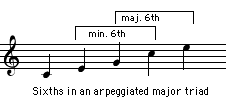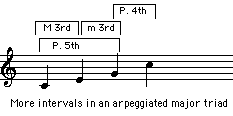Answer: One of the oldest is "My Bonnie Lies Over the Ocean" for the major sixth, if anyone still knows those songs that used to be sung in every elementary school. Along those lines, the first three notes of "Are You Sleeping, Brother John" outline the major third. "The Blue Danube" waltz begins with an upward major third, and so do about 3298 other pieces, while the famous beginning of Beethoven's Fifth Symphony is a downward major third. If you've ever seen the ancient TV show and movie "Dragnet," its theme is part of the memory of every person of a certain age: it outlines an upward minor third and really clinches it by jumping down again.

Personally I find it easier to think in terms of major and minor triads, root position and inverted. Once you have these down they become unconscious. The problem with the traditional method of using a familiar tune is that you must mentally get into the key of the tune first - and the interval you're hearing may have a different relationship to the tonic than it does in the familiar tune. For example, you might be hearing something in D minor, and the melody skips from E up to C#. Maybe you can mentally switch to A major and hear that as the first two notes of My Bonnie in the key of A, but for me it's easier to hear the E, C# as part of an inverted A major triad independent of any key: you can think E, A, C#, (or E, C#, A, like a doorbell). Or if it was C natural that could be part of E-G-C; a major triad starting on its middle note (i.e. in first inversion). That would make it a minor sixth. It will have to be one of those if it's a sixth. So, try using the first note as the middle pitch of a major triad, and leap to the octave. If that's a match you've got a minor sixth. Or try it as the upper pitch of a major triad and leap to the third above the octave. If that's a match you're dealing with a major sixth.

Sounds complicated, but it really isn't so bad. Learn the sound of the major and minor triads starting on any of their notes (i.e. inverted or not), and that gives you the major and minor thirds, perfect 4th and perfect fifth, and the major and minor sixths. It even helps with the octave. That leaves only the major and minor seconds - probably not an issue - and the minor and major sevenths. But a similar trick works with those: the minor seventh seems to want to move down a half step and become a major sixth; so if you know the major sixth that's done ( I think that might be easier than "There's a Place for Us" from West Side Story, a popular mnemonic for the minor seventh, but tastes differ). And the major seventh yearns to become an octave; it's almost there.

There's no easy answer for the augmented fourth (tritone) and diminished fifth, which sound the same, but I tend to think of them as almost a perfect fifth. If you wanted to keep the chord method for those, too, you'd need to outline a dominant seventh chord mentally; the diminished fifth is between the second pitch and the fourth one. For tunes using the tritone there's "Maria," Leonard Bernstein's inside joke for musicologists, again from West Side Story (in traditional styles of composition the interval of the tritone is a definite no-no in melody).
I think it's generally accepted that the major and minor sixth are the hardest to distinguish. But know them as parts of the triad and that unlocks almost everything.

